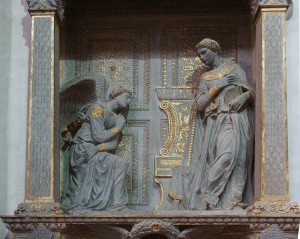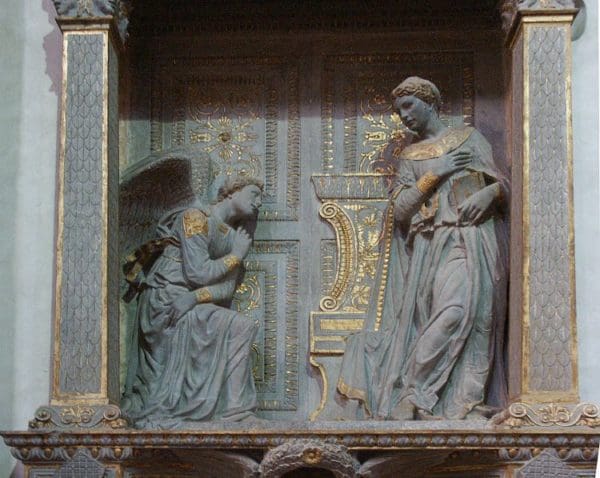“The world is not only hungry for food, but also for beauty.” With those words, Blessed Mother Teresa of Calcutta helps explain why Pope Benedict is encouraging us to return to Catholic art as  a privileged place for prayer. The vision of a gifted, accomplished, faith-filled artist can reveal to us a glimpse of God’s beauty, sparking an encounter with his love – and that’s the heart of all Christian prayer.
a privileged place for prayer. The vision of a gifted, accomplished, faith-filled artist can reveal to us a glimpse of God’s beauty, sparking an encounter with his love – and that’s the heart of all Christian prayer.
When I was just discovering the Catholic faith, before entering the Catholic Church, I used to wander into churches and gaze at the works of art, sometimes for hours at a time (college students have plenty of free time). This high relief sculpture of the Annunciation caught my eye, and my heart, even before I discovered that the Renaissance master, Donatello, had carved it out of pietra serena (a type of gray sandstone native to Tuscany) in the early 1400s.
What I Wasn’t Looking For
I have to make a confession about this work of art. It is located in a famous Italian Gothic church in Florence, Santa Croce. This church is home to immortal monuments like frescoes by Giotto, chapels by Brunelleschi, and the tombs of Galileo and Michelangelo. The first time I visited this church, I was interested in those famous monuments, not in Donatello’s little relief sculpture. Likewise the second time, and the third. In fact, this Florentine treasure of a church became a favorite stop on my way to class – I would light a candle for prayer intentions there as a part of my morning routine.
These repeated visits brought me in regular contact with Donatello’s Annunciation. It is located on the right side of the nave, between other monuments and side altars. I would walk by it every time I went through the church. Gradually, day by day, it began to demand more attention.
An Elegant Drama
We are used to seeing this type of depiction of the Annunciation, the moment when the Archangel Gabriel appears to the Blessed Virgin Mary and invites her to be the Mother of our Lord. But Donatello was the first sculptor to depict this scene with such drama. And it was the drama that struck a chord with me.
On the one hand, we can see that St. Gabriel is interrupting Our Lady. She is just closing her little prayer book with one hand, and with the other hand, she is pulling her cloak over her as if to protect herself. Her right knee is turning away from the angel, but her left foot is still planted and hasn’t yet caught up with her body’s motion. But even while her body is moving away from the angel, as if she is surprised or frightened, her face and head show that she is actually mesmerized by the vision and the angelic presence.
And isn’t that exactly how it is with all of us? When God breaks into our lives, interrupting our routine with an invitation to repent, or to serve in a new way, or to somehow follow him more closely, isn’t our automatic reaction one of fright or resistance? We say, “Well, Lord, I have a lot to do, and I don’t think your idea is going to fit into my plans.” And yet, even as we resist, there is a place in our hearts, way down deep, at the very core of our being, where we feel the excitement and the draw of the Christian adventure. We know that we are made for God and that his will is the path to the meaningful, worthwhile life that we truly desire. And so, our true self – represented in the sculpture by the Virgin’s face, since the face is always the fullest expression of the person – wants to pay attention to God’s voice and invitations as they stir our hearts and conscience. But our lower tendencies of selfishness, represented by the lower body of the figure in the sculpture, tend to flee from the Lord. As St. Paul put it: “For I delight in the law of God, in my inner being, but I see in my members another law waging war against the law of my mind…” (Romans 7:22-23).
The Charm of Grace
The charming elegance and sincere reverence with which Donatello depicts that drama was something else that resonated with me, in addition to the drama itself. In Mary’s case, the interior battle was much less violent than in our case. She was preserved from original sin and free from personal sin. And so, though the angel’s message caused her to be “greatly troubled” (Luke 1:29), she recovered quickly. Donatello’s rendition captures in Mary’s postures and attitudes the graciousness and gracefulness of her soul: he says with pietra serena what Gabriel said in words: “Hail, full of grace!” How could I not be attracted and intrigued by such beauty? How could I not be inspired by seeing Mary’s natural agitation being conquered by her supernatural affinity for God?
The year that I visited Santa Croce so frequently was the year that God first began calling me into his Catholic Church. Throughout that year, I played out in my own soul this drama that Donatello captures so beautifully. My lower self resisted God’s interruptions, but my soul was mesmerized, and dazzled, and won over by the sheer goodness and beauty of God.
This Advent, as we spend time contemplating Our Lady’s journey of faith, so full of joy and trepidation, perhaps admiring Donatello’s magnificent snapshot will release the adventuresome spirit within us, and give us a share of Mary’s courage so that we, like her, can answer God’s invitation (whatever it may be) with the perfect prayer: “Behold the handmaid of the Lord, let it be done unto me according to thy word” (Luke 1:38).
+
Art for this post on Hidden Delights: Detail of Annunciation Calvalcanti, Donatello, undated, photographed by robinelaine, 11 February 2009, CCA-2.0 Generic, Wikimedia Commons.





